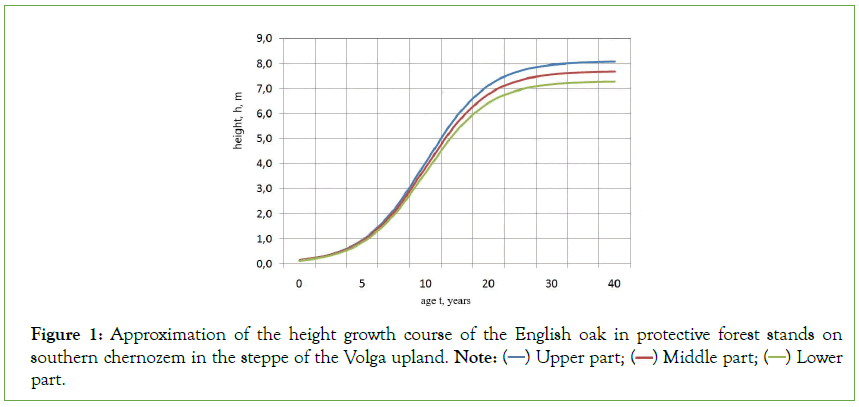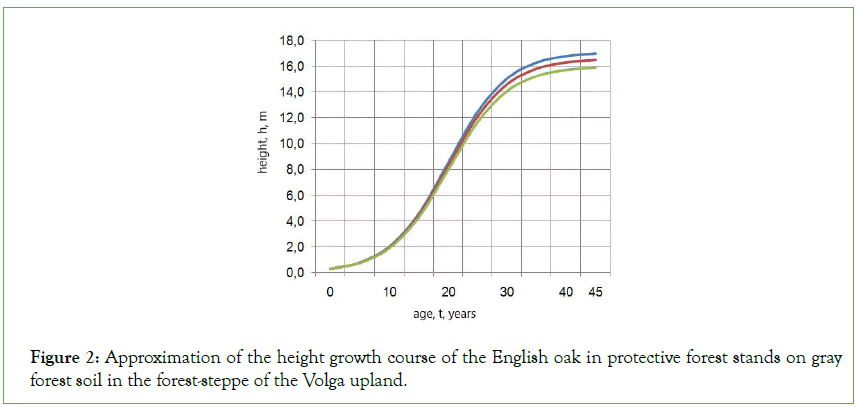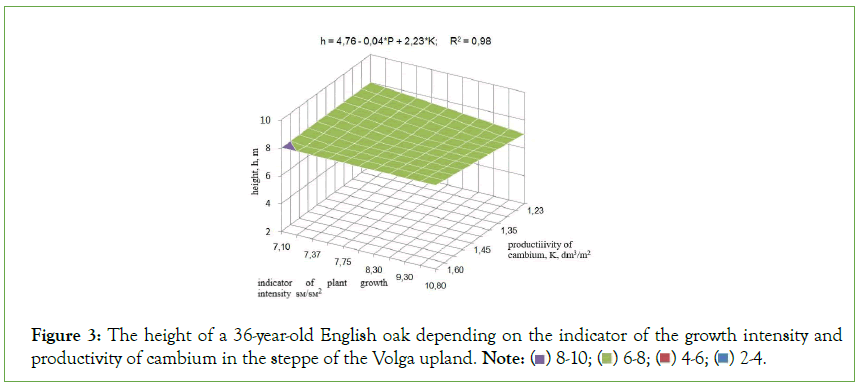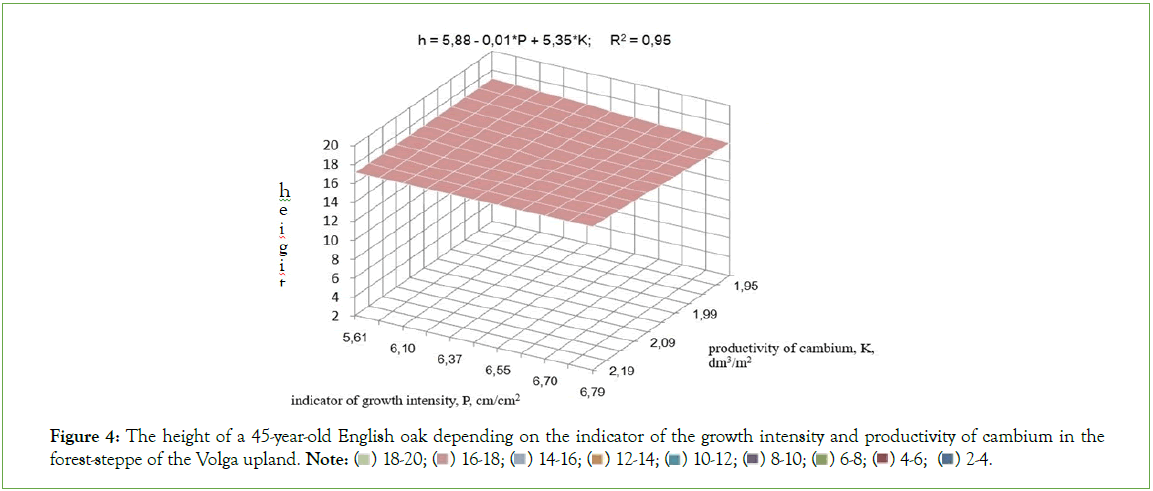Indexed In
- Open J Gate
- Genamics JournalSeek
- Academic Keys
- ResearchBible
- Cosmos IF
- Access to Global Online Research in Agriculture (AGORA)
- Electronic Journals Library
- RefSeek
- Directory of Research Journal Indexing (DRJI)
- Hamdard University
- EBSCO A-Z
- OCLC- WorldCat
- Scholarsteer
- SWB online catalog
- Virtual Library of Biology (vifabio)
- Publons
- Geneva Foundation for Medical Education and Research
- Euro Pub
- Google Scholar
Useful Links
Share This Page
Journal Flyer

Open Access Journals
- Agri and Aquaculture
- Biochemistry
- Bioinformatics & Systems Biology
- Business & Management
- Chemistry
- Clinical Sciences
- Engineering
- Food & Nutrition
- General Science
- Genetics & Molecular Biology
- Immunology & Microbiology
- Medical Sciences
- Neuroscience & Psychology
- Nursing & Health Care
- Pharmaceutical Sciences
Research Article - (2022) Volume 11, Issue 3
Regularities of the English Oak Growth in the Protective Plantings of the Steppe and Forest-Steppe of the Volga Upland
Proezdov Piotr Nikolaevich1*, Leskov Dmitry Vladimirovich1*, Mashtakov Dmitry Anatolyevich1*, Avtonomov Alexey Nikolaevich2* and Rozanov Alexander Vladimirovich3*2Department of Biological Sciences, Saratov State Vavilov Agrarian University, Saratov, Russia
3Department of Economic Cybernetics, Saratov State Vavilov Agrarian University, Saratov, Russia
Received: 04-Apr-2022, Manuscript No. AGT-22-16007; Editor assigned: 07-Apr-2022, Pre QC No. AGT-22-16007 (PQ); Reviewed: 20-Apr-2022, QC No. AGT-22-16007; Revised: 27-Apr-2022, Manuscript No. AGT-22-16007 (R); Published: 04-May-2022, DOI: 10.35248/2168-9881.22.11.251
Abstract
Regularities of the English oak growth in the protective plantings of the steppe and forest-steppe of the Volga upland
The purpose of the study is to establish the regularities of the English Oak growth in protective forest stands on erosion-prone slopes in the steppe and forest-steppe of the Volga upland. Studies have established a natural decrease in the height of the English oak on the southern chernozem and gray forest soil by 6.9%-11.3% with a slope grade increase by 2 times, which is associated with a drop in soil fertility as a result of increased erosion. The index of oak growth intensity with an increase in slope grade increases on both types of soils by 21.4%-38.5%, and the cambium productivity decreases by 14.1%-23.6%. The same trends in the dynamics of taxation indicators refers to the accompanying English oak species – Norway maple and small-leaf linden. The determination coefficient of the connection of the English oak growth in the height with the index of growth intensity and productivity of cambium are 0.95-0.98, which indicates a close interdependence.
Keywords
Bacterial inoculation; Deficit irrigation; Fatty acid; Flax; Oilseed; Protein
Introduction
English oak (Quercus robur) is the most common and main species used in protective afforestation in the steppe and forest-steppe of the Volga upland of Russia. High productivity of oak on chernozem and gray forest soils, survival and drought resistance, allow to grow protective forest plantations with high taxation indicators [1-3]. In many respects, the productivity and English oak condition depend on the mixing scheme used, the choice of the accompanying species and timely agrotechnical and forestry care in protective plantings [4-6].
Materials and Methods
The purpose of the study is to establish the regularities of the English Oak growth in the steppe and forest-steppe of the Volga upland.
The experiments were carried out on the southern chernozem of the Volga upland steppe in the farm «Forest» of the Tatishchevsky district of the Saratov region and on the gray forest soil of the Volga upland forest-steppe in the «New Chemeevo» farm of the Morgaushsky district of the Chuvash Republic [Proezdov, Mashtakov, Razarenov, 2013; Mashtakov, Avtonomov, Proezdov, 2018] [7].
Scientific and industrial erosion control stations include: in the southern chernozem-two 36-year-old flow-regulating forest strips of dense construction, 57 m wide, with 19 rows-have the composition of: 5 English Oak (Quercus robur), 3 Norway Maple (Acer platanoides), 2 Green Ash (Frahinus lanceolata). Along the edges of the forest strip there are shrubs – Russian olive (Elaeagnus angustifolia) and golden currant (Ribes aureum). Tree species grow according to the third class of bonitet. The protective height of the forest strip is 8.5 m; on gray forest soil-protective forest stands aged 45 years have a composition of 6 English Oak and 4 small-leaf Linden (Tilia cordata), growing in the second-third class of bonitet with a protective height of 15.4 m.
The methodology and methods of research are based on the Forest Code of the Russian Federation using the organization principles of the classical forestry theory and practice, forest taxation, agroforestry, standard and private methods of planning and conducting experiments. The plantings were studied by forest taxation methods with the taking of model trees (OST 56-69-83) and using the methodology of the Research Institute of Agroforestry for protective forest plantations [8].
The dependence of the oak height on the age was established according to the regression equation of A. Mitcherlich:

To study the communication between tree species in protective forest stands and the viability of plantings,the K.K. Vysotsky method was used [1], with the help of which the following quantitative indicators were determined: (a) the growth intensity index (PNR) the ratio of the tree height to the cross-sectional area at chest height; (b) the coefficient of competitive relations (KKO)-the ratio of the growth intensity of the species having the best growth (the smallest PNR) to the growth intensity of each other species in the same plantation; (c) the degree of the planting stability (CYN) – the ratio of the actual amount of KKO and the maximum possible.
Cambium productivity – the ratio of wood growth by a year or a period of years volume to the surface area of cambial tissue was calculated using the complex dependence of S.S. Pyatnitsky, according to the formula we transformed [9].
PK=1.68х+3.65z – 0.05 (2)
Where PK is-cambium productivity, dm3/m2; х-average accretion in height, m;
z-Average increase in diameter, sm.
The processing of the research materials was carried out according to the methodology of [10] using professional versions of the package of standard computer programs: Statistica, SciLab and the «Table processor analysis Package» MS Excel.
Results and Discussion
Comprehensive consideration of natural and anthropogenic factors affecting the growth and productivity of tree species in protective forest stands, in particular, English oak, because of their diversity, is a very difficult task. From a fundamental point of view, the totality of natural and anthropogenic factors is a multidimensional hypersurface, the detailed study of which is complicated by the complexity of its structure. We used mathematical models and methods that allowed us to take into account the impact on the English oak growth of the oak tree of the most significant of the factors that allow for a mathematical description available for use: diameter, growth intensity index, cambium productivity.

where, h-is the height of the English oak, m; D-is the diameter of the oak at chest height, cm; P is the growth intensity index, cm/cm2; K-is the cambium productivity, dm3/m2; b0-b7 are multiple regression coefficients.
The study of forestry and taxation parameters of tree species in protective forest stands on various parts of the slope showed a regular growth dynamics. With an increase in the steepness of the slope, the taxation indicators of tree species naturally decrease, primarily the boniteness of oak, which is associated with a drop in soil fertility as a result of erosion [Mashtakov, Berlin., Proezdov., Dubrovin, 2015; Proezdov, Mashtakov, Razarenov, 2010] [2,3]. The height of an oak tree with an increase in steepness by 1.9-2.3 times on southern chernozem and gray forest soil decreases by 6.9-11.3%, and the diameter-by 13.9-24.2%. The oak growth intensity index increases by 21.4-38.5% with an increase in the slope grade, and the productivity of the cambial tissue decreases by 14.1-23.6%. The same trends in the dynamics of forestry and taxation indicators are similar in related species. There is a high, more than 71%, vital condition of tree species in protective plantings (Tables 1 and 2).
| Forest strips location on the slope | Species | Medium | PNR, sm/sm2 |
KKO | CYN | PK, dm3/m2 | Vital condition, % | |||
|---|---|---|---|---|---|---|---|---|---|---|
| D, sm | Z, sm/year | H | Х, m/year | |||||||
| m | ||||||||||
| Upper part, steepness 3о | Dch Ko | 11,8 | 0,33 | 7,9 | 0,22 | 7,23 | 1,00 | 1,52 | 82 | |
| 11,0 | 0,30 | 7,1 | 0,20 | 7,47 | 0,96 | 1,96 | 1,38 | 82 | ||
| Medium part, steepness 5о | Dch Ko | 10,9 | 0,30 | 7,5 | 0,21 | 8,04 | 1,00 | 1,40 | 77 | |
| 9,9 | 0,28 | 6,4 | 0,18 | 8,32 | 0,97 | 1,97 | 1,27 | 78 | ||
| Lower part, steepness 7о | Dch Ko | 9,5 | 0,26 | 7,1 | 0,20 | 10,02 | 1,00 | 1,23 | 74 | |
| 8,7 | 0,24 | 6,1 | 0,17 | 10,27 | 0,98 | 1,98 | 1,11 | 71 | ||
Note: Dch- English oak; Ko-Norway maple; Д-diameter, sm; Z-increase in diameter, sm/гyear; Н-Height, m; Х-accretion in height, m/year; PNR-growth intensity index, sm/sm2; KKO-coefficient of competitive relations; CYN-the degree of plantings stability; PK-cambium, productivity, dm3/m2.
Table 1: Indicators of the tree species and the resilience of forest strips on the southern chernozem steppe of the Volga Upland communication.
| Protective forest stands location on the Slope | Species | Medium | PNR, sm/sm2 | KKO | CYN | PK, dm3/m2 |
Vital condition, % | |||
|---|---|---|---|---|---|---|---|---|---|---|
| D, sm | Z sm/year | Н, m | Х, m/year | |||||||
| Upper part, steepness 15о | Dch Lp | 19,7 | 0,44 | 17,1 | 0,38 | 5,61 | 1,00 | 2,19 | 87 | |
| 17, | 0,39 | 16,2 | 0,36 | 7,06 | 0,79 | 1,79 | 1,98 | 83 | ||
| 1 | ||||||||||
| Medium part, steepness 22о | Dch Lp | 18,1 | 0,40 | 16,6 | 0,36 | 6,45 | 1,00 | 2,01 | 84 | |
| 15, | 0,35 | 15,8 | 0,35 | 7,96 | 0,81 | 1,81 | 1,82 | 80 | ||
| 9 | ||||||||||
| Lower part, steepness 29о | Dch Lp | 17,3 | 0,38 | 16,0 | 0,35 | 6,81 | 1,00 | 1,92 | 81 | |
| 15, | 0,33 | 15,1 | 0,33 | 8,44 | 0,81 | 1,81 | 1,71 | 77 | ||
| 1 | ||||||||||
Note: LP-Big-leaf linden. The remaining designations are in Table 1.
Table 2: Indicators of the tree species and the resilience of protective forest stand on gray forest soil in the forest-steppe of the Volga Upland.
The dynamics of accretion in height of the English oak, depending on age, shows that in the first 4-6 years, the species develop mainly the root system, and then the crown. The dependence of the growth course in an oak height on age is described by the equation of A.Mitcherlich (1) (Figures 1 and 2).

Figure 1: Approximation of the height growth course of the English oak in protective forest stands on
southern chernozem in the steppe of the Volga upland. Note: Lower part.
Lower part.

Figure 2: Approximation of the height growth course of the English oak in protective forest stands on gray forest soil in the forest-steppe of the Volga upland.
For the three regression curves (Figure 1), the parameter are a2=0.2, a₃=10 and the values of parameter a1 for the upper, middle and lower parts of the slope are respectively 8.1; 7.7 and 7.3. For the three regression curves (Figure 2), parameters are: a2=0.2, as=40, and the values of parameter a1 for the upper, middle and lower parts of the slope are 17.1, 16.6 and 16.0 respectively.
Regression and correlation analysis has shown that from the variety of natural and anthropogenic factors affecting the English oak height growth, an indicator of the growth intensity associated with the diameter of the species and the productivity of cambium, depending on the increments in diameter and height, have an effect. The coefficients of determination are 0.95-0.98, which indicates a close relationship of the studied features (Figures 3 and 4).

Figure 3: The height of a 36-year-old English oak depending on the indicator of the growth intensity and
productivity of cambium in the steppe of the Volga upland. Note: 2-4.
2-4.

Figure 4: The height of a 45-year-old English oak depending on the indicator of the growth intensity and productivity of cambium in the
forest-steppe of the Volga upland. Note: 2-4.
2-4.
The results of the study were implemented in the farms «Lesnoe» of the Tatishchevsky district of the Saratov region (steppe of the Volga upland) and «NOVOE Chemeevo» of the Morgaushsky district of the Chuvash Republic (forest-steppe of the Volga upland).
The area of protective forest plantations on the slopes with the main oak species is 14.5 hectares, which protect 227 hectares of pasture lands with a forest cover of 6.4% and an increase in the productivity of pasture grasses by 15%-45%.
Conclusion
The analysis of the English oak growth notes a close communication between the height of the main tree species with age and taxation parameters with determination coefficients of 0.89-0.98. Long-term studies of forestry and taxation indicators of the English oak and its accompanying species of Norway maple and small-leaf linden allowed them to be recommended on erosion- prone slopes in protective forest stands.
REFERENCES
- Vysotsky KK (1962) Regularities of the structure of mixed stands. KK. Vysotsky, Moscow: Goslesbumizdat.
- Mashtakov DA, Berlin NG, Proezdov PN, Dubrovin VV. The state of oak protective forest strips in the conditions of the southern chernozem of the steppe. Scientific life. 2015; 6:143-156.
- Proezdov PN, Mashtakov DA, Razarenov AI. Regularities of productivity and growth of protective forest plantations on chernozem soils of the Saratov Right Bank . Niva Povolzhya. 2010;4(17):81-85.
- Mikhin VI, Mikhina EA. Formation of protective stands of oak petiolate in the Central Chernozem Region of Russia. Forestry journal. 2018; 8(4):109-117.
- Mikhina EA, Tanyukevich VV, Mikhin VI. Аgri-environmental role of protective forest plantations. IOP Conf. Ser: Earth Environ. Sci. 2019;392:012066.
- Ovington JD. Quantitative ecology and woodland ecosystem concept. In Advances in ecological research. 1962;1:103-117.
- Mashtakov DA, Avtonomov AN, Proezdov PN (2018). Protective forest plantings in the forest-steppe of the Volga upland. Cheboksary, publishing house of the Chuvash University.
- Pavlovsky ES, Dovgilevich MI (1985) The methodology of system research forest-agrarian landscapes //M. Academy of agricultural Sciences, VNIALMI. 1985.
- Pyatnitsky SS (1963). Vegetative forest// M. 136 pp.
- Dospekhov BA (2012). The methodology of field experience (with the basics of statistical processing of research results) Demand Book, Moscow.
Citation: Nikolaevich PP, Vladimirovich LD, Anatolyevich MD, Nikolaevich AA, Vladimirovich RA (2022) Regularities of the English Oak Growth in the Protective Plantings of the Steppe and Forest-Steppe of the Volga Upland. Agrotechnology. 11:253.
Copyright: © 2022 Nikolaevich PP, et al. This is an open-access article distributed under the terms of the Creative Commons Attribution License, which permits unrestricted use, distribution, and reproduction in any medium, provided the original author and source are credited.permits unrestricted use, distribution, and reproduction in any medium, provided the original author and source are credited.


